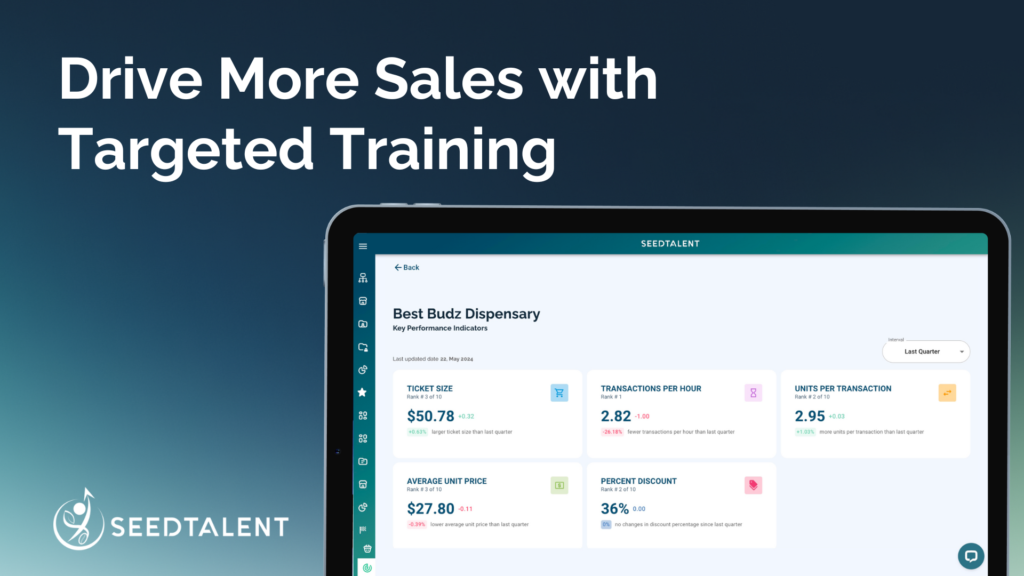Driving Dispensary Growth
At Seed Talent, we’re driven to improve cannabis retail as a whole—for store owners, brand owners, and employees. That’s why we’re continually adding features to our robust learning management system software to track crucial analytics, improve training for utmost success, and, most importantly, increase sales.
Today, we’re excited to announce the launch of our latest feature, the Performance Scorecard! This feature gives cannabis retail owners the power to view vital operational Key Performance Indicators (KPIs) per individual employee and individual store to drive retail growth.
Ready to learn about how to define and implement operational KPIs for retail success? Keep reading to learn how to increase the value of your front-line employees with crucial data collection. Plus, you’ll get insight on the most recent upgrade to our data-driven learning system, which leading retailers have implemented across the US.
KPIs to Track for Cannabis Retail
Simply put, operational data = actionable insights. When tracking KPIs relevant to your cannabis retail store’s goals (we’ll get into that next) and growth, you can use that data to better train your employees.
For instance, with Seed Talent, the industry’s leading learning management system, you can track the following KPIs from location to location, employee to employee:
- Basket size
- Revenue per hour
- Percentage of house brands sold
- Transactions per hour
- Units per transaction
With this tool, you can then see these rankings compared to the store average and the store goal, and easily select and target employees for additional training to improve. Seed Talent allows for views per store location and per employee, allowing for even more granular data.
Overall, tracking and reporting on these crucial KPIs give you the ability to see where your sales are trending, who’s helping the trend, or who needs additional training.
How to Define Goals for Retail Growth
Of course, to know which KPIs you should be tracking for your own cannabis retail store, it’s essential to establish clear, achievable goals first. These goals should align with your overall business strategy and be specific, measurable, achievable, relevant, and time-bound (SMART).
For help on defining goals for retail growth, here are a few best practices to do so:
- Assess Current Performance: Begin by evaluating your store’s current performance. Analyze sales data, customer feedback, and market trends to understand where you stand. This will provide a baseline against which you can measure growth.
- Identify Key Growth Areas: Determine the areas that offer the most significant growth potential. This could include increasing sales, improving customer satisfaction, expanding product lines, or enhancing operational efficiency.
- Set Specific Targets: Define clear, specific targets for each growth area. For example, you might aim to increase monthly sales by 20% over the next year or reduce customer returns by 10% in the next 6 months.
- Align with Business Strategy: Ensure your growth goals align with your broader business strategy. For instance, if your strategy focuses on premium products, your goals might emphasize upselling higher-margin items.
- Involve Your Team: Engage your team in the goal-setting process. This fosters a sense of ownership and ensures everyone is committed and aligned to the same north star.
Tips for Tracking & Reporting Crucial KPIs
Often, business owners are too busy to dive any deeper into the POS system they have for insights or data. They don’t possess the bandwidth or tools to connect that data to individual employees to make decisions for the growth of their store.
So, what is the #1 tip for tracking and reporting crucial KPIs? Getting an automated system that does it for you! Seed Talent provides a proven framework for training employees and then tracking, reporting, and incentivizing their success.
Even better, tracking and reporting KPIs can help boost employee morale. With data showing high upsells, or cross-sells, you can not only celebrate top-performing employees but also identify opportunities for improvement among the staff to boost performance (and self-esteem).

Best Practices for Implementing KPI-to-Staff Tracking
Remove emotion and subjectivity when evaluating employees by giving both managers and budtenders a clear view of their performance. As a result, not only do owners, investors, and store managers welcome the software and new training programs with open arms, but budtenders will reap the benefits too.
When implementing a new KPI tracking process into your business’ SOPs, it’s best to involve your staff at every level. That means inviting your staff during the demo phase to show the true value of new processes, and promoting continuous improvement.
Performance Scorecards for Sales Success
Operational KPIs are vital tools for driving retail growth in the cannabis industry. By defining clear growth goals and implementing relevant KPIs, you can gain valuable insights into your store’s performance and make data-driven decisions that propel your business forward.
Remember, the key to engaging employees in the success of your business lies in continuous monitoring, analysis, and adaptation to market dynamics. With the right approach, your cannabis retail store can achieve sustainable profitability.
Ready to take the right approach for your business? Harness the power of operational data and transform raw metrics into actionable insights with Seed Talent Performance Scorecards. This latest advanced feature empowers your teams with clear KPIs, enhancing their understanding and connection to business objectives.
Sign up for a demo of Seed Talent to see our Performance Scorecards more in depth today!




